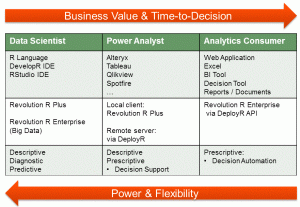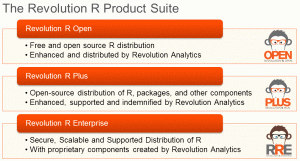Revolution Analytics presented to the BBBT last Friday. The company is focused on R with a stated corporate vision of “R: The De-facto standard for enterprise predictive analytics .” Bill Jacobs, VP, Product Marketing, did most of the talking while Steve Belcher, Sales Engineer, gave a presentation.
For those of you unfamiliar with R as anything other than a letter smack between Q and S, R is an open source programming language for statistics and analytics. The Wikipedia article on R points out it’s a combination of Scheme and S. As someone who programmed in Scheme many years ago, the code fragments I saw didn’t look like it but I did smile at the evolution. At the same time, the first thing I said when I saw Revolution’s interactive development environment (IDE) was that it reminded me of EMACS, only slightly more advanced in thirty years. The same wiki page referenced earlier also said that R is a GNU project, so now I know why.
Bill Jacobs was yet another vendor presenter who has mentioned his company realized that the growth of the Internet of Things (IOT) means a data explosion that leaves what is currently misnamed as big data in the dust as far as data volumes. He says Revolution wants to ensure that companies are able to effectively analyze IOT and other information and that his company’s R is the way to do so.
Revolution Analytics is following in the footsteps of many companies which have commercialized freeware over the years, including Sun with Unix and Red Hat with Linux. Open source software has some advantages, but corporate IT and business users require services including support, maintenance, training and more. Companies which can address those needs can build a strong business and Revolution is trying to do so with R.
GUI As Indicative Of Other Issues
I mentioned the GUI earlier. It is very simple and still aimed at very technical users, people doing heavy programming and who understand detailed statistics. I asked why and was told that they felt that was their audience. However, Bill had earlier talked about analytics moving forward from the data priests to business analysts and end users. That’s a dichotomy. The expressed movement is a reason for their vision and mission, but their product doesn’t seem to support that mission.
Even worse was the response when I pointed out that I’d worked on the Apple Macintosh before and after MPW was released and had worked at Gupta when it was the first 4GL language on the Windows platform. I received as long winded answer as to why going to a better and easier to use GUI wasn’t in the plans. Then Mr. Jacobs mentioned something to the effect of “You mentioned companies earlier and they don’t exist anymore.” Well, let’s forget for a minute that Gupta began a market, others such as Powersoft did well too for years, and then Microsoft came out with its Visual products to control the market but that there were many good years for other firms and the products are still there. Let’s focus on wondering when Apple ceased to exist.
It’s one thing to talk about a bigger market message in the higher points of a business presentation. It’s another, very different, thing to ensure that your vision runs through the entire company and product offering.
Along with the Vision mentioned above, Revolution Analytics presents a corporate mission to “Drive enterprise adoption of R by providing enhanced R products tailored to meet enterprise challenges.” Enterprise adoption will be hindered until the products reflect an ability to work for more than specialist programmers but can address a wider enterprise audience.
Part of the problem seems to be shown in the graphic below.

Revolution deserves credit for accurately representing the current BI space in snapshot. The problem is that it is a snapshot of today and there wasn’t an indication that the company understands how rapidly things change. Five to ten years ago, the middle column was the left column. Even today there’s a very technical need for the people who link the data to those products in order to begin analysis. In the same way, much of what is in the right column was in the middle. In only a few years, the left column will be in the middle and the middle will be on the right.
Software evolves rapidly, far more rapidly that physical manufacturing industries. Again, in order to address their enterprise mission, Revolution Analytics’ management is going to have to address what’s needed to move towards the right columns that mean an enterprise adoption.
Enterprise Scalability: A Good Start
One thing they’ve done very well is to build out the product suite to attract different sized businesses, individual departments and others with a scaled product suite to attract a wider audience.

Revolution Analytics product suite
They seem to have done a good job of providing a layered approach from free use of open source to enterprise weight support. Any interested person should talk with them about the full details.
Summary
R is a very useful analytical tool and Revolution Analytics is working hard to provide business with the ability to use R in ways that help leverage the technology. They’re working hard to support groups who want pure free open source and others who want true enterprise support in the way other open source companies have succeeded in previous decades.
Their tool does seem powerful, but it is still clearly and admittedly targeted at the very technical user, the data priests.
Revolution Analytics seems to have a start to a good corporate mission and I think they know where they want to end up. The problems is that they haven’t yet created a strategy that will get them to meet their vision and mission.
If you are interested in using R to perform complex analysis, you need to talk to Revolution Analytics. They are strong in the present. Just be aware that you will have to help nudge them into the future.